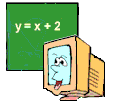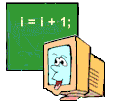|

The
equal sign (=) is used for assigning values to variables.
The format of an assignment is:
variable = expression;
The variable
is a variable name that you defined in the program.
The expression is any
variable, numerical, literal, or expression that produces a data type
that is the same as the variable's data type.
|
Data may be placed in a
variable when it is declared:
int grade = 98;
or data may be placed in a
variable AFTER it has been declared
(at a point further down
in the program):
int grade;
...
grade = 98; |
|
Never put commas in numerical values
that you assign to variables.
The following statement is invalid:
double sales = 87,463.95;
//Don't do this!!!!
|
|
Are
computers and mathematicians always speaking the same
language? |
|
A computer does not
interpret an equal sign in the same manner that
mathematicians do. To a computer, the equal sign means
that you want to take the number, variable, or expression
on the right side of the equal sign and put it into the
variable on the left.
|
 |
A computer understands:
grade = 98;
but a computer does not understand
98 = grade; |
 |
|
The statement
x = x + y;
may look mathematically incorrect, but to a computer it
means "take what was stored in
x,
add
y to that
value, and place the answer back in
x".
Remember that what is on the right side will be STORED in
the variable on the left.
|
Mathematician:
 |
i = i +
1
"NO
way!!" |
|
Computer:

"Way cool!!" |
 |
|
|
|
Answer:
While they
agree on concepts, they do not necessarily agree on
syntax (the manner in which the concepts are expressed). |
|
|
Compound Operators:
C++ has its own
shortcut syntax involving the placement of values into
numerical variables. You should be able to recognize all
possible codings.
x += y; is the same as
x = x + y;
x -= y; is the same as
x = x - y;
x *= y; is the same as
x = x * y;
x /= y; is the same as
x = x / y;
x %= y; is the
same as x = x % y;
While a powerful tool
used to update variables, compound operators can be
troublesome. In the order of operations, the compound
operators have lower precedence than regular math operators.
Check out these two examples:
int x = 42;
int value = 0;
value = value - x + 2;
cout<< value; //gives - 40 |
int x =
42;
int value = 0;
value -= x + 2;
cout<<value; //gives - 44 |
Be careful when using
compound operators. Remember the operator precedence. |
|